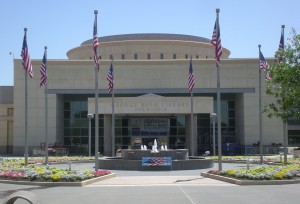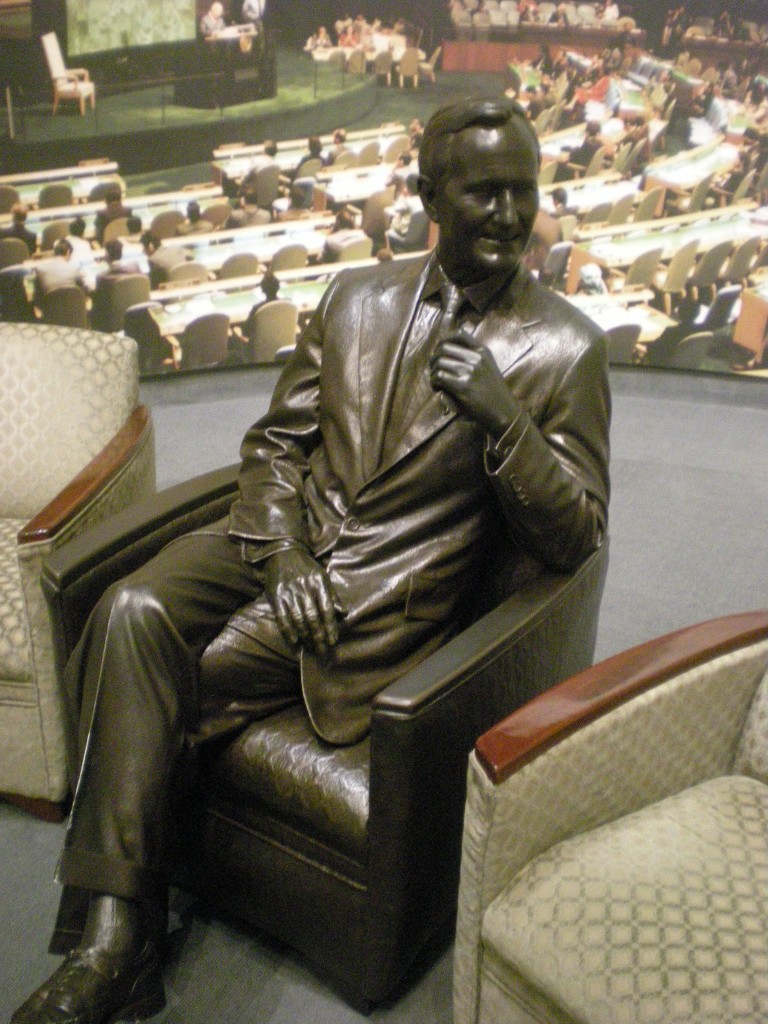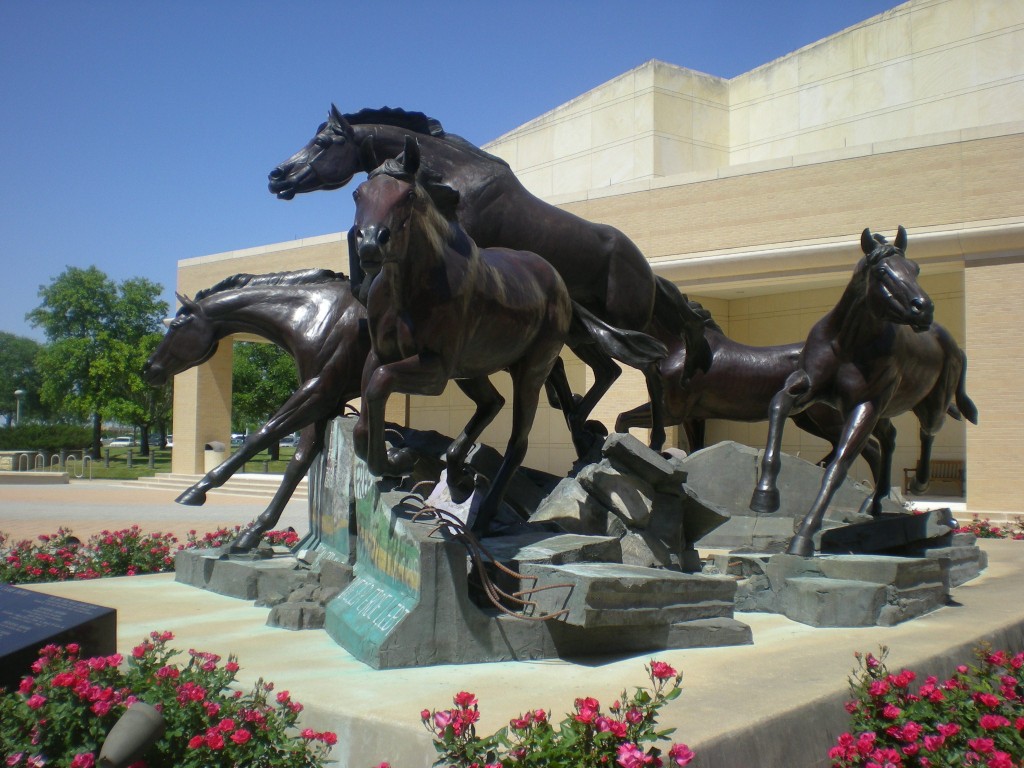I’m told that we went to the Eisenhower Library when I was a child, but I don’t remember it. Since then I’ve visited other presidential libraries or museums: Lincoln, Hoover, Truman, Johnson, Nixon, Ford, Carter. And now the George Bush Presidential Library, focusing on George Bush the elder. Jay and I visited just before we left College Station.
 His library opened in 1997 on the Texas A&M campus, though it’s way out from everything else. Bush didn’t attend A&M, famously being a Yale man, but presumably the Aggies put in the best bid. Besides, he did make his name in the oil business in Texas. A&M oversees the place with the National Archives and Records Administration. It’s an HOK design, which from the front looks a little like it’s missing a dome.
His library opened in 1997 on the Texas A&M campus, though it’s way out from everything else. Bush didn’t attend A&M, famously being a Yale man, but presumably the Aggies put in the best bid. Besides, he did make his name in the oil business in Texas. A&M oversees the place with the National Archives and Records Administration. It’s an HOK design, which from the front looks a little like it’s missing a dome.
Presidential history’s interesting (of course it is), but I thought that the most interesting exhibit in this particular museum was a temporary one about offshore oil drilling. Called “Offshore Drilling: The Promise of Discovery” (sponsored by Shell), the museum says that it’s “a tribute to [Bush’s] role in the development and use of the innovative independent leg offshore jack-up rig Scorpion launched by LeTourneau in 1956… It focuses on the history, development and future of offshore drilling, with an emphasis on the work of George Bush, emerging technologies and ongoing research at Texas A&M University.”
An independent leg offshore jack-up rig is a mobile offshore platform stable enough for the open ocean, but flexible enough to be moved when the time comes. Before 1956, offshore platforms mostly had to be fixed permanently to the bottom, limiting their usefulness; the few floating platforms couldn’t stand heavy seas, so they tended to be near shore. LeTourneau was an inventor: Robert Gilmour LeTourneau (1888-1969). He was, says Wiki, “a prolific inventor of earthmoving machinery. His machines represented nearly 70 percent of the earthmoving equipment and engineering vehicles used during World War II, and over the course of his life he secured nearly 300 patents.”
Drilling Contractor (Sept/Oct 2005) further tells the story: “Although the concept of a deep-sea, mobile offshore platform aroused considerable interest among the oil companies, none of the companies were prepared to help finance construction of such an expensive (nearly $3 million) and unproven project. Then [in the early 1950s] Mr. LeTourneau proposed the idea to Zapata Off-Shore Company of Houston, headed by future United States President George H.W. Bush.” (The article is here.)
Zapata. You have to like that name for an oil company. (Apparently Bush and his partners were inspired by the movie Viva Zapata!) So Zapata became the first oil company to use an independent leg offshore jack-up rig. The exhibit tells that story, but even better, it includes models of various rigs, platforms and supply vessels that have been used over the years by the industry — exceptionally detailed models — as well as pieces of drilling equipment.
The rest of the museum has pretty much what you’d expect: exhibits about different stages of the life and career of George Bush the elder, including his harrowing escapes from death as a naval aviator in the Pacific in 1944 (over the course of the year, his squadron suffered a 300 percent casualty rate), though no mention of this story that I saw, and his various public-sector jobs, both elected and appointed. A well-done set of displays, but even so it’s hard to think of any presidency that happened while you’re an adult as history.
Other items included a big hunk of the Berlin Wall, a replica Oval Office – any presidential museum worth its salt has one – and a life-sized bronze of Bush, depicting him as Ambassador to the United Nations.
 I didn’t make a picture of the oddest bit of art we saw in the museum. Called “1000 Points of Light,” it was painted for the Points of Light Foundation, which encourages volunteerism. A presidential George Bush reaches for a nimbus-ed U.S. flag, while a crowd of enraptured everyday Americans watches. I’d call the style Socialist Realism, but there’s no socialist content here. Maybe Volunteerist Realism. The artist is Frank Hopper, who seems to excel at this kind of thing, and is also fixated on mermaids.
I didn’t make a picture of the oddest bit of art we saw in the museum. Called “1000 Points of Light,” it was painted for the Points of Light Foundation, which encourages volunteerism. A presidential George Bush reaches for a nimbus-ed U.S. flag, while a crowd of enraptured everyday Americans watches. I’d call the style Socialist Realism, but there’s no socialist content here. Maybe Volunteerist Realism. The artist is Frank Hopper, who seems to excel at this kind of thing, and is also fixated on mermaids.
Stranger still are the ghost presidents in the sky, watching. And not just any ghost presidents. With the exception of Washington and Jefferson and either Madison or Monroe, all the rest of them are ghost Republican presidents, all the way from Lincoln to Reagan. The faces are a little spectral, but I think the only ones left out are Arthur and Harding. Take a look.
In the plaza outside the museum stands another work of art, “The Day the Wall Came Down,” by Veryl Goodnight.
 Bronze horses racing over replicated bits of the Berlin Wall, with graffiti copied from the actual wall (the west side, naturally). With the horses, the plaque tells us, “representing the freedom of the human spirit.” Fine figures of horses, and all very kinetic, which is fitting for the destruction of the wall, but I’m not sure how well beasts of burden stand in for the unconquerable human spirit.
Bronze horses racing over replicated bits of the Berlin Wall, with graffiti copied from the actual wall (the west side, naturally). With the horses, the plaque tells us, “representing the freedom of the human spirit.” Fine figures of horses, and all very kinetic, which is fitting for the destruction of the wall, but I’m not sure how well beasts of burden stand in for the unconquerable human spirit.
Though the pieces of the Berlin Wall in “The Day the Wall Came Down” seem to be simulations, the sculpture (and the actual piece inside) did get me thinking. Like pieces of the World Trade Center, or moon rocks, where are all the scattered bits of that former communist concrete now? Relics tend to get around.